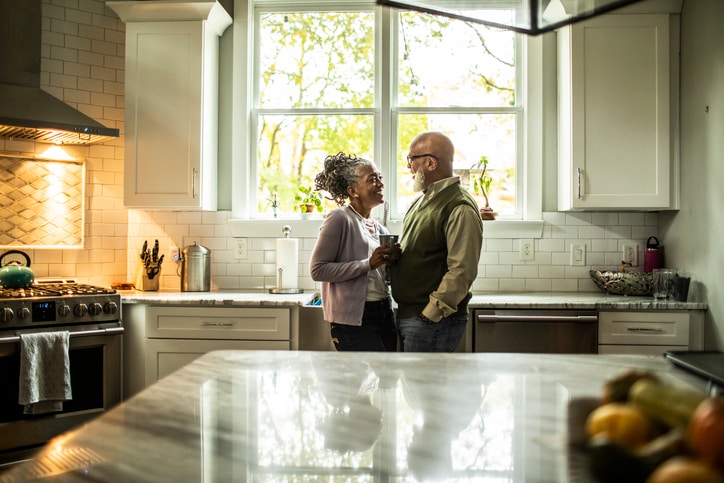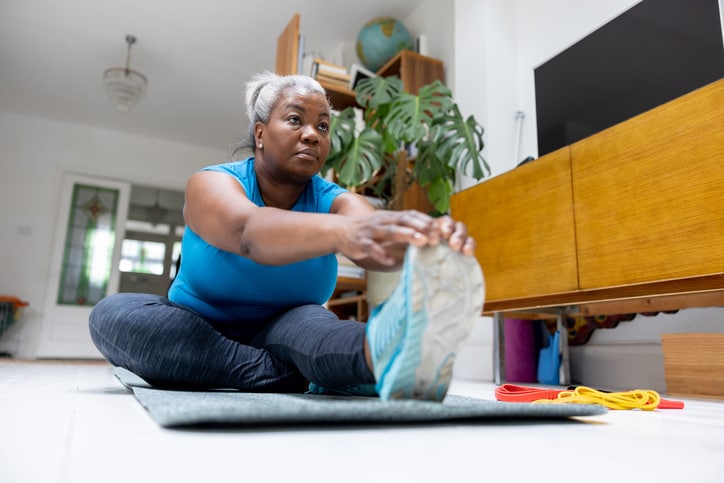There are a number of living options for older adults, one being independent senior living. Geared toward older adults that are — you guessed it — independent, these communities provide things like socialization, outings, fitness classes and more. Needless to say, they’re incredibly beneficial for senior well-being.
“In many cases, independent living communities allow seniors to live on their own without the burden of cooking, housekeeping or home repairs,” explains Benjamin Surmi, a social gerontologist and director of education and culture at Koelsch Communities, a senior living company with independent living, assisted living and memory care.
“Furthermore,” he continues, “independent living provides access to amenities, resources, services and other benefits.”
Whether you’re looking for yourself or a loved one, here’s everything to know about independent senior living.
“In many cases, independent living communities allow seniors to live on their own without the burden of cooking, housekeeping or home repairs.”
— Benjamin Surmi, social gerontologist and director of education and culture
What is independent living for seniors?
Find independent living near you
There are different types of independent senior living communities, but in the most basic terms, they’re residential communities designed for adults 55+ that offer room, board and other amenities for a monthly fee.
“Some are associated with assisted living, nursing homes and continuing care communities, which offer residents a certain level of medical assistance based on their needs and are priced relative to services,” explains Dr. Elizabeth Landsverk, a geriatrician and author of “Living in the Moment: A Guide to Overcoming Challenges and Finding Moments of Joy in Alzheimer’s Disease and Other Dementias.”
For the most part, though, independent living is for adults who live active, independent lifestyles. “Essentially, they can do everything for themselves and do not require assistance with activities of daily living,” says Ryan Majchrzak, owner of Assisted Living Locators Bel Air. “People living independently can still prepare their own meals, manage their household, use the bathroom and shower without assistance or safety concerns and manage their own medications.”
That being said, many independent senior living communities offer meals, housekeeping and more (more on this shortly!).
Independent living vs. other senior housing options
While there can be many variables in the offerings from place to place, independent living communities generally differ from other senior house options in some or all of the following ways:
Food
Independent senior living communities typically provide between one to three meals per day, which are included in the cost of living in the community. “For those at which one meal is included, there are still restaurants and other dining options available at which residents can purchase meals,” explains Majchrzak. “Other senior living options are senior apartments, where residents must prepare their own meals or go out into the community at large.”
Transportation
While residents can still own and utilize a car, independent senior living communities also offer alternative transportation. “Many have shuttles that take residents to grocery stores, restaurants and other services,” notes Majchrzak.
Activities
Many independent senior living communities come with built-in entertainment, such as scheduled events and resident-led clubs and organizations. “These communities offer a more vibrant lifestyle, where residents have more opportunities to get involved,” Majchrzak says. “With other senior housing options, residents must create their own social experience.”
Amenities
Again, each independent living community is different, but many boast amenities that aren’t available with other senior housing options. “Some are equipped with state-of-the-art fitness centers, offering a wide range of free weights and other exercise equipment,” says Landsverk. “Some offer 24/7 concierge, laundry, putting greens, libraries and more.”
Price
Given what they provide, it’s no surprise that many independent senior living communities are pricey. “Independent living communities are paid at a monthly rate, which is typically much higher than one would pay for a mortgage in a condo or rent in an apartment,” Majchrzak says. “And depending on the state, these communities may not accept Medicaid.”
What are the different types of independent senior living?
Independent living communities run the gamut in terms of housing options. “There are apartments, suites, townhomes and cottages,” Surmi says. “Different options can meet people’s specific needs, preferences and budgets.”
Further, Majchrzak says, they can include “active 55+ senior communities, senior apartments, subsidized apartments for those 62+ or disabled and continuing care retirement communities.”
“Additionally,” he continues, “there are senior communities that provide independent living, assisted living and memory care within the same building.”
Landsverk adds that, popular now, are communities that draw upon a theme that appeals to a particular demographic. “For instance, we’re seeing a Disney-themed community currently being built in Palm Springs and then there’s Latitude Margaritaville, which was inspired by musician Jimmy Buffett and boasts a theme built on ‘food, fun, music and escapism,’” she says.
Benefits of independent senior living
The biggest benefits, according to Surmi, are that older adults get “the comforts of home, access to amenities and a maintenance-free lifestyle.”
“Residents can play bridge with friends, meet neighbors to knit, spend the evening stargazing with guidance from a local astronomy professor, take an exercise class and much more,” Surmi continues. “These offerings empower residents to thrive physically, emotionally and socially.”
“Residents can play bridge with friends, meet neighbors to knit, spend the evening stargazing with guidance from a local astronomy professor, take an exercise class and much more.”
— Benjamin Surmi, social gerontologist and director of education and culture
Features to look for when considering independent living
When evaluating independent living communities, Surmi says it’s important to be thoughtful and thorough. He adds: “I recommend people consider the factors that are important to them and what they need from an independent living community to fully pursue their passions, achieve their goals, and position themselves confidently for years to come.”
In other words, make sure the amenities offered are ones you or your older loved one will take advantage of. “If enjoying gourmet meals is your passion, there are many upscale facilities that offer fine dining,” explains Landsverk. “Some are equipped with yoga studios, lap pools and tennis courts. Do your research and find just the right fit.”
Other features to consider when choosing an independent living community, according to Surmi:
- Location.
- Food quality.
- Safety and security.
- Amenities that help residents stay independent longer. “Consider how a community is structured to do this,” he says. “Look for communities that offer such services as assistance with laundry or transportation to appointments.”
Other factors to consider
In addition to the amenities and features offered at an independent senior living community, here’s what else to keep in mind:
Level of assistance
“Independent living communities encourage people to live independently as long as possible,” explains Surmi. “For residents who find they need personal medical care, they can hire a caregiver, nurse or other medical service provider.”
That being said, explains Surmi, some independent living communities, when developed in affiliation with assisted living, “do provide different levels of care to independent living residents.” Having access to such support, keep in mind, is beneficial from a continuum of care standpoint.
Health services
To the point above, Majchrzak recommends asking about the health services offered at each community, regardless of affiliation. “Do they have a visiting doctor or health clinic? Are pharmacy services offered in the community or can prescriptions be delivered out of convenience?” he says. “Ask if there are nursing services offered at the community and whether the nurse is on staff or if they have a delegating nurse that visits on a scheduled basis. Some communities offer podiatry, psychotherapy, dental services and more — but not all of them.”
Finances
Whether renting or buying, most independent living communities aren’t cheap. “[In some cases], renting requires signing a lease and paying upfront fees before moving in,” says Landsverk. “Rents are typically between $1,000-$5,000 per month or more, not including utilities, and some amenities and services may have a cost attached.”
“When buying,” she continues, some communities require “a substantial upfront fee after which you’ll pay monthly maintenance fees, association dues, real estate taxes/assessments, renovations and utilities. Entrance fees can range anywhere from the low six figures to well over $1 million.”
“Rents are typically between $1,000-$5,000 per month or more, not including utilities, and some amenities and services may have a cost attached.”
— Dr. Elizabeth Landsverk, geriatrician and author
The bottom line
Independent senior living communities are great for aging adults who want to stay engaged socially, while having a place that truly feels like home — and who have the financial means.
“Moving into an independent living community can be quite costly, but also quite rewarding,” Majchrzak says. “Continuing to be engaged socially is so important to the health of seniors. If you move into one of these communities, getting involved and making friends is key. This can decrease the risk of depression and keep older adults physically active.”



